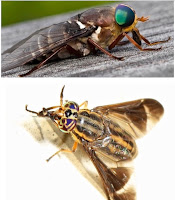He may be cute and winsome on video, but lately Gus is a major asshole. These past few weeks, the grass is delicious, the weather is brisk, and the biting flies are much reduced. Also, his paddock is muddy, so he’s mostly just standing and dozing on its small dry hill. Evidently those factors add up to a gluttonous, spirited, bored, and therefore outrageously disobedient donkey.
Sandy says he’s been pulling away from her quite often when she leads him between stall and paddock; with me too, he’s being a complete and utter shitheel. All he wants, all the time, is to graze. And when he’s indulging in his heart’s desire, he’s sweet as pie. But any alternative activity suggested by any human transforms him into a wicked, obstinate, sassy, vicious little monster. I hope he sits on a tack.
Today, as we walk from his paddock to the arena, he sets his neck, trots hard, pulls the lead rope from my hand, and runs into his favorite grazing area. Nothing new here. I allow him to eat for a good half-hour, but then I can’t get him to come off the lawn. I wait. I cajole. I lure. He tugs. He wrestles. He rams.
I know from painful experience that my psoas and other core muscles cannot survive being yanked and torqued by an 800-pound bundle of pure insistence. So I drop the rope, go fetch a long lungeing whip, and return, whapping it on the ground behind him to send him scurrying. If he’s going to disobey, at least he won't get to keep gorging on grass. So say I . . . But he outmaneuvers me, and before I can run over and stop him, he crouches and crawls under a fence board to escape into the adjoining pasture. There the three resident horses — very big, very athletic geldings — greet him joyously and commence galloping around with him.
Gus still has his long rope trailing from his halter, and that’s a safety hazard for all parties. So now I climb through the fence, into the melee of flying heels and thundering hooves, to try to unsnap the damn lead-line. I secure my own personal space by blocking the horses with the lunge whip, but that keeps Gus out of reach too. Finally I make my way through the hullabaloo, speak quietly to Gus and approach him, and remove the rope.
Now the youngest and silliest gelding is herding Gus in a small circle at high speed, while Gus tries to get himself onto the far side of the older horse, whom he’s more familiar with. When you see him right next to these big ex-racehorses, Gus is a shrimp, a peanut, a bug. He’s gamely galloping about, grunting and squeaking as he kicks vigorously at the horses, but to them he’s just a big toy. At this point he's wishing he hadn't busted into this paddock after all, and he begins eyeing the fence. He rams his chest against a board, breaking it like a ballbat, but it’s too high for him to jump. Harrassed by hijinks, he doesn’t have time to drop low and scoot under again. I run to the pasture gate and invite him out that way, but he’s still fooling around with the three big boys.
Anyway, now the hilarity is waning, and I figure he’s just fine. (He used to be turned out here with the geldings regularly, but he kept busting out when he got bored. That’s why he’s in a different turnout now: it’s small enough to encircle with electrified wire, which is the only way to keep Gus in.) I leave them to their own devices and help a friend who’s training Gus’s pasturemate -- a very nice, very polite gelding, thank you very much. A few minutes later, when I glance out to the big paddock, I see Gus and his merry band just grazing placidly.
When Sandy arrives, she helps me lead/shoo Gus into the arena. She picks up a lunge whip and stations me at the arena gate with another whip. And she chases him around that arena, turning on a dime and switching the whip to her other hand in order to cut him off and turn him if he tries to run past her. When he does head toward the gate, I’m there brandishing my whip, sending him back into the ambit of Sandy’s whip. After just five minutes, he’s slowing down, so Sandy slows and relaxes her energy. They both stop moving, and the former fiend turns and faces her quietly and submissively, just as if he’s memorized the horse-whisperer’s handbook. He goes up to her, she gives him nice scritches, and they turn and walk slowly toward the gate. When she stops, he stops next to her. When she walks again, he comes along with her. It’s magic, only it’s real.
At the gate, I clip the lead onto him and we stroll ever so nicely into his stall, where I dump his dinner into his feed bucket for him.

















.jpg)